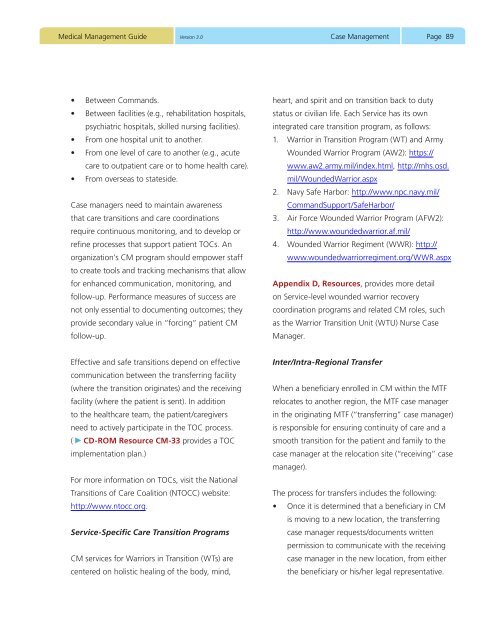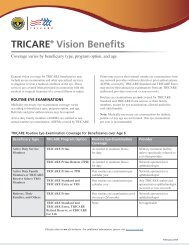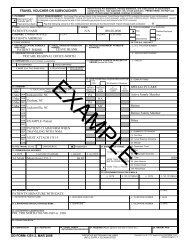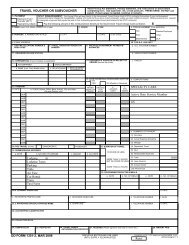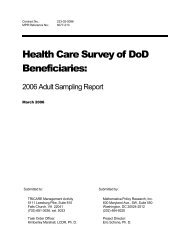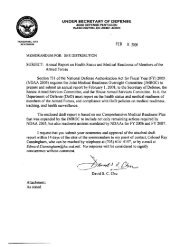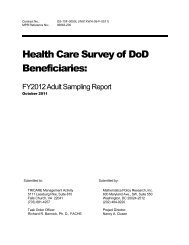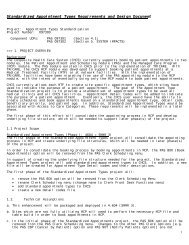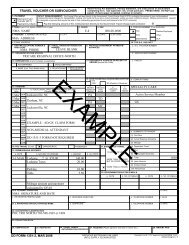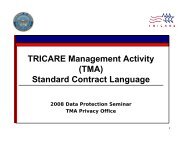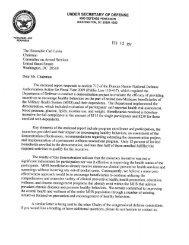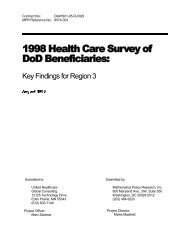Medical Management Guide, 2009, Version 3.0 - Tricare
Medical Management Guide, 2009, Version 3.0 - Tricare
Medical Management Guide, 2009, Version 3.0 - Tricare
- No tags were found...
Create successful ePaper yourself
Turn your PDF publications into a flip-book with our unique Google optimized e-Paper software.
<strong>Medical</strong> <strong>Management</strong> <strong>Guide</strong><strong>Version</strong> <strong>3.0</strong>Case <strong>Management</strong>Page 89• Between Commands.• Between facilities (e.g., rehabilitation hospitals,psychiatric hospitals, skilled nursing facilities).• From one hospital unit to another.• From one level of care to another (e.g., acutecare to outpatient care or to home health care).• From overseas to stateside.Case managers need to maintain awarenessthat care transitions and care coordinationsrequire continuous monitoring, and to develop orrefine processes that support patient TOCs. Anorganization’s CM program should empower staffto create tools and tracking mechanisms that allowfor enhanced communication, monitoring, andfollow-up. Performance measures of success arenot only essential to documenting outcomes; theyprovide secondary value in “forcing” patient CMfollow-up.heart, and spirit and on transition back to dutystatus or civilian life. Each Service has its ownintegrated care transition program, as follows:1. Warrior in Transition Program (WT) and ArmyWounded Warrior Program (AW2): https://www.aw2.army.mil/index.html, http://mhs.osd.mil/WoundedWarrior.aspx2. Navy Safe Harbor: http://www.npc.navy.mil/CommandSupport/SafeHarbor/3. Air Force Wounded Warrior Program (AFW2):http://www.woundedwarrior.af.mil/4. Wounded Warrior Regiment (WWR): http://www.woundedwarriorregiment.org/WWR.aspxAppendix D, Resources, provides more detailon Service-level wounded warrior recoverycoordination programs and related CM roles, suchas the Warrior Transition Unit (WTU) Nurse CaseManager.Effective and safe transitions depend on effectivecommunication between the transferring facility(where the transition originates) and the receivingfacility (where the patient is sent). In additionto the healthcare team, the patient/caregiversneed to actively participate in the TOC process.( CD-ROM Resource CM-33 provides a TOCimplementation plan.)For more information on TOCs, visit the NationalTransitions of Care Coalition (NTOCC) website:http://www.ntocc.org.Service-Specific Care Transition ProgramsCM services for Warriors in Transition (WTs) arecentered on holistic healing of the body, mind,Inter/Intra-Regional TransferWhen a beneficiary enrolled in CM within the MTFrelocates to another region, the MTF case managerin the originating MTF (“transferring” case manager)is responsible for ensuring continuity of care and asmooth transition for the patient and family to thecase manager at the relocation site (“receiving” casemanager).The process for transfers includes the following:• Once it is determined that a beneficiary in CMis moving to a new location, the transferringcase manager requests/documents writtenpermission to communicate with the receivingcase manager in the new location, from eitherthe beneficiary or his/her legal representative.


